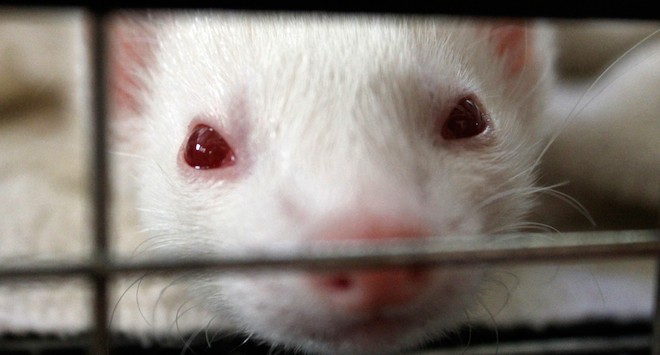
Image: Shane Byrd (CC), Flickr
A controversy that has been brewing for several years in the world of influenza research may ignite again with the publication last week of a new paper that’s worth a read. I haven’t to date written about the controversy, which centers on what’s called “gain of function” research. In the case of flu, what is being gained (via lab manipulation) is the ability for flu to transmit easily from one lab animal to another. The strains being manipulated are already virulent, that is, causing severe illness; and novel — that is, humans have never experienced them before, and so have no immunity to them. Adding transmissible to virulent and novel brings flu into the territory of becoming a potential pandemic strain. That’s where the controversy is, and what this new paper addresses.
A bit of recap first: The controversy over gain-of-function research dates back to 2011, when Ron Fouchier at Erasmus Medical Centre in the Netherlands and Yoshihiro Kawaoka at the University of Wisconsin both disclosed that their labs were tinkering with the H5N1 strain of avian flu. At that point, public health had been watching H5N1 for about 6 years as it spread slowly from southeast Asia. The strain caused severe illness, killing up to two-thirds of people made sick by it, but except in rare instances only occurred in people who had some direct contact with poultry, and did not transmit easily person-to-person. The discovery that transmissibility was being added to the virus’s toolkit, even if just between ferrets in the confines of moderately high-security labs, caused an uproar. The quasi-governmental National Science Advisory Board for Biosecurity examined both the papers and, very unusually, recommended that details be stripped from them before they were published. The fight that occasioned held up both papers as details were argued over, but they were eventually both published in full, Fouchier in Science and Kawaoka in Nature, in mid-2012. (Nicholas Evans’ 2013 essay at SciAm covers the arguments in detail.)
The research met with such an outcry that the two scientists and 38 other prominent flu researchers announced a voluntary moratorium on “gain of function” studies throughout 2012 — but then announced in 2013, to more outcry and disagreement, that they were going to resume. Since then, those teams and others have proposed gain-of-function studies on H7N9 avian flu (more details in this story by Helen Branswell) and more recently on H7N1 avian flu (details in this story from CIDRAP). “Gain of function” research being conducted in the US is now subject to some pre-publication review — but that review, for instance, didn’t prevent the H7N1 paper from being published, even though some reviewers felt the benefits of the research did not outweigh its risks. Several of those reviewers proposed last month that a national board be set up specifically to conduct such pre-publication reviews in the US. Two weeks ago a similar proposal was made in Germany, and the implications of gain-of-function research were also recently examined in the French newspaper Le Monde.
None of the scrutiny has significantly deterred the gain-of-function researchers, though — and that’s where last week’s paper comes in. The authors are Marc Lipsitch of Harvard, who has persistently criticized the “gain of function” studies, and Alison Galvani of Yale. They argue that the research is so inherently dangerous that it requires an independent, comprehensive risk-benefit analysis that should be made public before any more studies are undertaken.
One often-cited criticism of these studies is that the infected lab animals could pass the enhanced strains to a lab worker, who then would spread that accidental infection with the novel virus to others. Lipsitch and Galvani take that possibility seriously enough to work out the math, and the probabilities they come up with are daunting:
These studies have typically been conducted in biosafety level (BSL) 3 or 3+ containment facilities. Laboratory-associated infections in BSL3 facilities are conservatively estimated to occur at a rate of two per 1,000 laboratory-years in the United States, where protocols and enforcement are relatively stringent. Globally, high-containment laboratories have variable standards and enforcement. Experimentation in less-regulated or unregulated laboratories, with the attendant risks of accidental or deliberate release, is facilitated by the publication of sequence and functional data on PPPs, even if the original research was conducted with state-of-the-art safety and security.
From the conservative estimate of the rate of laboratory-associated infections of two per 1,000 laboratory-years, it follows that a moderate research program of ten laboratories at US BSL3 standards for a decade would run a nearly 20% risk of resulting in at least one laboratory-acquired infection, which, in turn, may initiate a chain of transmission. The probability that a laboratory-acquired influenza infection would lead to extensive spread has been estimated to be at least 10%. Simple branching process models suggest a probability of an outbreak arising from an accidental influenza infection in the range of 5% to 60%.
As alternatives to the current “gain of function” studies, Lipsitch and Galvani recommend a menu of experimental approaches that they contend would be both safer and more informative: modeling, sequence comparisons from existing databases, single-protein studies, and examination of lab-constructed reassortant strains that would retain the viral-surface proteins to which some human immunity exists. (The full menu of recommendations is here.)
Probably predictably, the researchers who first advanced the gain-of-function studies dismiss the critique; CIDRAP collected their reactions. What’s important, though, is whether these proposals will stimulate a re-examination of the risks of gain-of-function studies among governments, funders, and the universities hosting the labs. The possibility of a lab escape may be lower than these authors estimate — but the results are so potentially dire that it would be important to know that running the risk is worthwhile.
Cite: Lipsitch M, Galvani AP (2014) Ethical Alternatives to Experiments with Novel Potential Pandemic Pathogens. PLoS Med 11(5): e1001646. doi:10.1371/journal.pmed.1001646